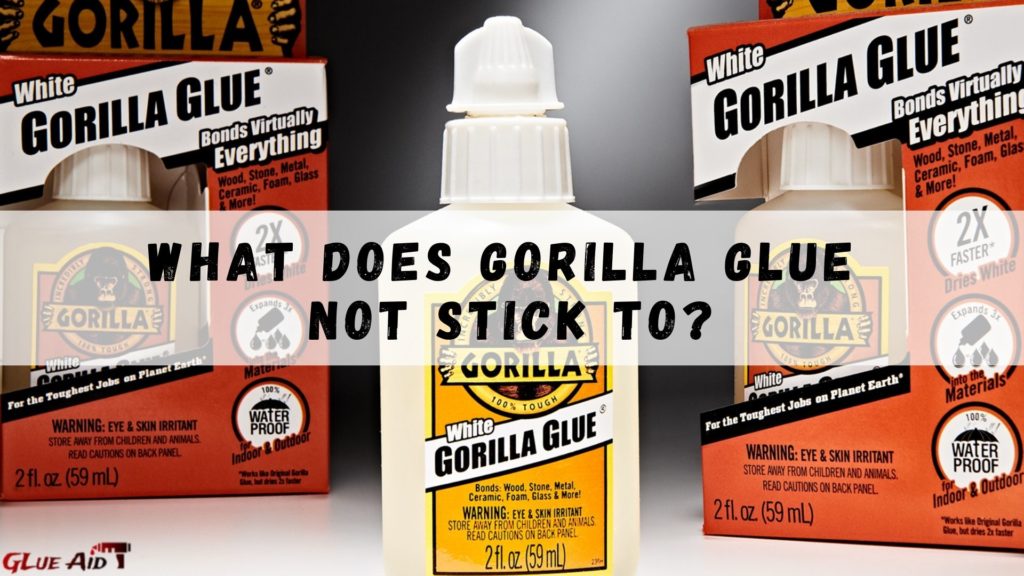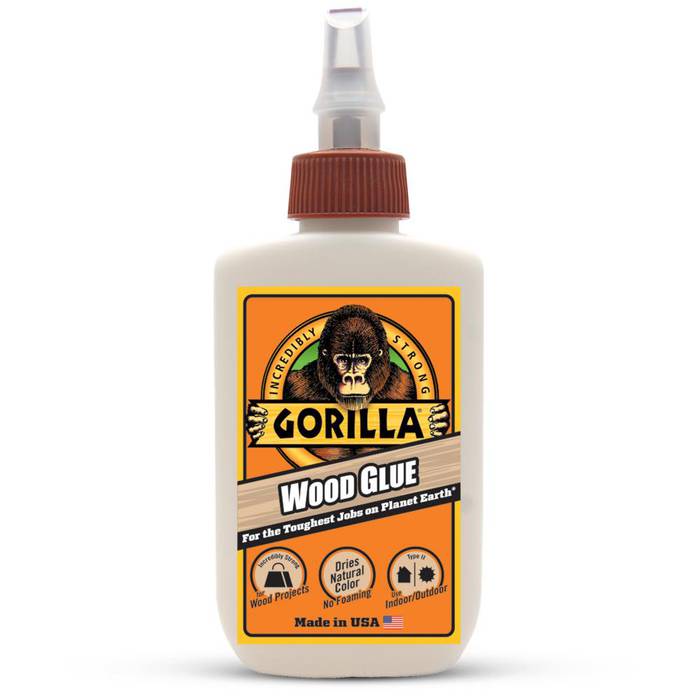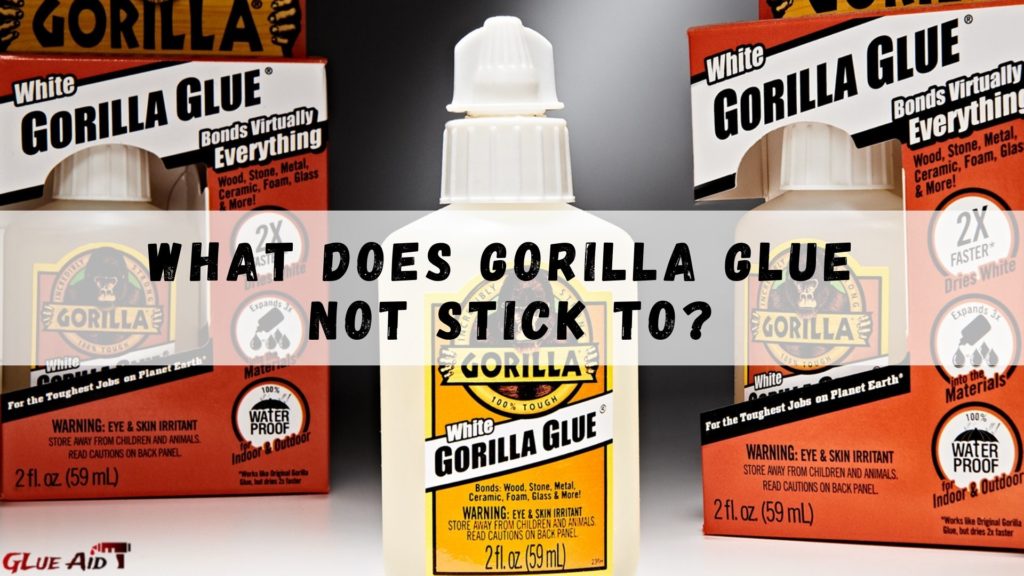Have you ever wondered what materials Gorilla Wood Glue just won’t stick to? Well, wonder no more! In this article, we’ll explore the fascinating world of Gorilla Wood Glue and its limitations. So, whether you’re planning a woodworking project or just curious about the wonders of adhesives, this is the perfect read for you.
When it comes to Gorilla Wood Glue, it’s essential to know what it can and can’t bond. While it’s known for its incredible strength and versatility, there are a few surfaces that it simply won’t adhere to. In the following paragraphs, we’ll uncover those elusive materials that remain untamed by this mighty glue.
But fear not! If you’re thinking of using Gorilla Wood Glue for your project, we’ve got you covered. By the end of this article, you’ll have a clear understanding of what Gorilla Wood Glue can and can’t stick to, ensuring your next woodworking endeavor is a resounding success! So, let’s dive in and discover the surprising limitations of this remarkable adhesive.

The Surprising Truth: What Does Gorilla Wood Glue Not Stick To?
If you are a DIY enthusiast or a professional woodworker, chances are you have used Gorilla Wood Glue at some point. With its strong adhesive properties, it is a popular choice for bonding wood surfaces. However, there are instances where Gorilla Wood Glue may not work as effectively. In this article, we will explore what Gorilla Wood Glue does not stick to, helping you make informed choices in your woodworking projects.
The Factors That Affect Gorilla Wood Glue’s Bonding Ability
Before we dive into the specific materials that Gorilla Wood Glue may not stick to, it’s important to understand the factors that can affect its bonding ability. Gorilla Wood Glue is known for its excellent bond strength, but it is not invincible. Several factors can impact the adhesion, including:
1. Moisture Content:
Gorilla Wood Glue works best when the moisture content of the wood is between 10% to 15%. Excessively dry or wet wood can interfere with the glue’s ability to penetrate the fibers, resulting in a weaker bond. It is essential to properly prepare the wood surfaces and ensure they are within the recommended moisture range for optimal adhesion.
Avoid using Gorilla Wood Glue on wood that is extremely dry or saturated with water, as it may compromise the bond strength and overall durability of your project.
2. Surface Texture:
The texture of the wood surfaces also plays a role in Gorilla Wood Glue’s bonding ability. While Gorilla Wood Glue is designed to bond porous materials, extremely smooth or nonporous surfaces may pose a challenge for the glue to create a strong bond. It is recommended to roughen or score the surfaces to enhance adhesion, especially when working with materials like laminates or hardwoods with smooth finishes.
Now that we understand the factors that can affect Gorilla Wood Glue’s effectiveness, let’s explore the materials that it may not stick to.
Materials Gorilla Wood Glue May Not Stick To
1. Plastic:
Gorilla Wood Glue is not suitable for bonding plastic surfaces. Its formulation is specifically designed for wood-to-wood bonding and may not adhere properly to plastic materials. For plastic projects, it is best to choose an adhesive formulated for plastic bonding.
2. Metals:
Gorilla Wood Glue is not designed for bonding metal surfaces. While it may have some initial grip on metal, it does not provide a reliable and durable bond over time. For metal bonding applications, it is recommended to use a specialized metal adhesive.
3. Glass:
Gorilla Wood Glue is not suitable for bonding glass surfaces. Glass is smooth and nonporous, making it difficult for the adhesive to create a strong bond. If you need to bond glass to wood or other materials, consider using a glass adhesive specifically formulated for that purpose.
4. Concrete:
Gorilla Wood Glue is not designed for bonding concrete surfaces. Concrete is a highly porous material that requires a specialized adhesive with strong bonding properties to ensure a reliable and long-lasting bond. When working with concrete, choose an adhesive specifically formulated for concrete bonding.
5. Fabrics:
Gorilla Wood Glue is not recommended for bonding fabrics or textiles. Its formulation is designed to penetrate and bond wood fibers, and it may not provide the flexibility and strength required for fabric bonding. For fabric projects, it is best to use an adhesive specifically formulated for fabric bonding.
6. Smooth and Nonporous Surfaces:
Gorilla Wood Glue works best on porous surfaces, such as wood and some types of stone. Smooth or nonporous surfaces, like metal, glass, or plastic, do not provide enough surface area for the glue to form a strong bond. It is important to choose the right adhesive for the specific materials you are working with to ensure a successful bond.
Tips for Effective Adhesion with Gorilla Wood Glue
While Gorilla Wood Glue may not stick to certain materials, it is still a versatile and reliable adhesive for woodworking projects. Here are some tips to help you achieve the best adhesion:
1. Prepare the Surfaces:
Ensure that the surfaces to be bonded are clean, dry, and free from any dust, oils, or contaminants. Proper surface preparation is crucial for optimal adhesion.
2. Apply Even Pressure:
Once you have applied the Gorilla Wood Glue and joined the surfaces, apply even pressure using clamps or other holding mechanisms. This will ensure maximum contact between the surfaces and the glue, enhancing the bond strength.
3. Allow Sufficient Drying Time:
Gorilla Wood Glue requires some time to dry and reach its full strength. Follow the recommended drying time provided by the manufacturer before subjecting the bonded surfaces to any stress or load.
4. Consider Mechanical Fasteners:
If you are working with materials that Gorilla Wood Glue may not stick to, such as plastic or metal, consider using mechanical fasteners like screws, nails, or bolts to augment the bond strength.
In Summary
Gorilla Wood Glue is a reliable and strong adhesive for woodworking projects, but it may not adhere well to certain materials like plastic, metal, glass, concrete, and fabrics. Understanding its limitations and choosing the appropriate adhesive for your project is crucial. By following proper surface preparation techniques and using the right bonding agents, you can ensure strong and durable bonds in your woodworking endeavors.
Key Takeaways: What Does Gorilla Wood Glue Not Stick To?
- Gorilla wood glue does not stick to plastic surfaces.
- It is not effective on non-porous materials like metal or glass.
- Gorilla wood glue may not work well on oily or greasy surfaces.
- It is not recommended for bonding rubber or silicone materials.
- Gorilla wood glue may struggle to adhere to wet or damp surfaces.
Frequently Asked Questions
Welcome to our Frequently Asked Questions section where we address queries related to the topic of what materials Gorilla Wood Glue does not stick to. Check out the questions below to learn more about the stickiness of this popular adhesive!
1. Is Gorilla Wood Glue suitable for gluing metal surfaces?
Gorilla Wood Glue is primarily designed for bonding wood surfaces together, and it may not provide a strong bond when used on metal. The composition and adhesive properties of Gorilla Wood Glue are optimized for wood, allowing for excellent adhesion and a strong bond. For metal-based projects, it is recommended to use an adhesive specifically designed for bonding metal surfaces to ensure a secure and durable connection.
If you need to glue metal surfaces together, it’s best to opt for a specialized metal adhesive or epoxy that can withstand the unique challenges posed by metal bonding.
2. Can Gorilla Wood Glue bond plastic materials effectively?
Gorilla Wood Glue is not intended for bonding plastic materials. While it may have some adhesion to certain types of plastics, it is not specifically formulated for plastic-to-plastic bonding. Plastic surfaces often require adhesives with specific chemical properties to ensure a reliable and strong bond. Gorilla Glue offers a range of adhesives that are specifically designed for bonding various types of plastics, such as their Gorilla Super Glue or Gorilla Epoxy.
If you are working with plastic materials, it’s best to choose an adhesive that is specifically recommended for plastic-to-plastic bonding to achieve the best results.
3. Will Gorilla Wood Glue stick to glass surfaces?
Gorilla Wood Glue is not designed to bond glass surfaces. Glass has a smooth and non-porous surface, which makes it challenging for regular wood glue to create a strong and long-lasting bond. For gluing glass, it is recommended to use an adhesive that is specifically formulated for bonding glass, such as a glass adhesive or a specialized glass glue.
Using the appropriate adhesive for glass will help ensure a secure bond and prevent the glued items from separating over time. Always follow the instructions provided by the adhesive manufacturer when working with glass surfaces.
4. Can I use Gorilla Wood Glue on oily or greasy surfaces?
It is generally not recommended to use Gorilla Wood Glue on oily or greasy surfaces. The presence of oil or grease can interfere with the adhesive’s ability to create a strong bond between two surfaces. Before applying Gorilla Wood Glue, it is important to ensure that the surfaces are clean and free from any oil, grease, or contaminants. Cleaning the surfaces with a suitable degreaser or rubbing alcohol can help prepare them for optimal adhesion.
If you are working with materials that have an oily or greasy residue, it is advisable to clean the surfaces thoroughly and, if needed, choose an adhesive specifically designed for bonding oily or greasy surfaces.
5. Will Gorilla Wood Glue adhere well to wet surfaces?
Gorilla Wood Glue is not formulated to bond wet surfaces. It is important to ensure that the surfaces you are gluing together are dry before applying the adhesive. Moisture can interfere with the glue’s ability to create a strong bond, potentially compromising the effectiveness and durability of the adhesive connection.
Prior to gluing, make sure the surfaces are clean and completely dry to achieve the best results with Gorilla Wood Glue. If you need to bond wet surfaces, consider using an adhesive that is specifically designed for such applications, like waterproof or marine-grade adhesives.

Summary
Gorilla wood glue is a strong adhesive that sticks to most surfaces, including wood, stone, and metal. However, there are a few materials it doesn’t adhere to. The glue does not stick well to plastic, glass, or oily surfaces. So, be careful when using it for these materials. Additionally, make sure to clean and prepare the surfaces properly for better adhesion.
In conclusion, Gorilla wood glue is versatile and reliable, perfect for all your woodworking needs. Just keep in mind its limitations with certain materials and ensure proper surface preparation. With Gorilla wood glue, your projects will stick together successfully!
